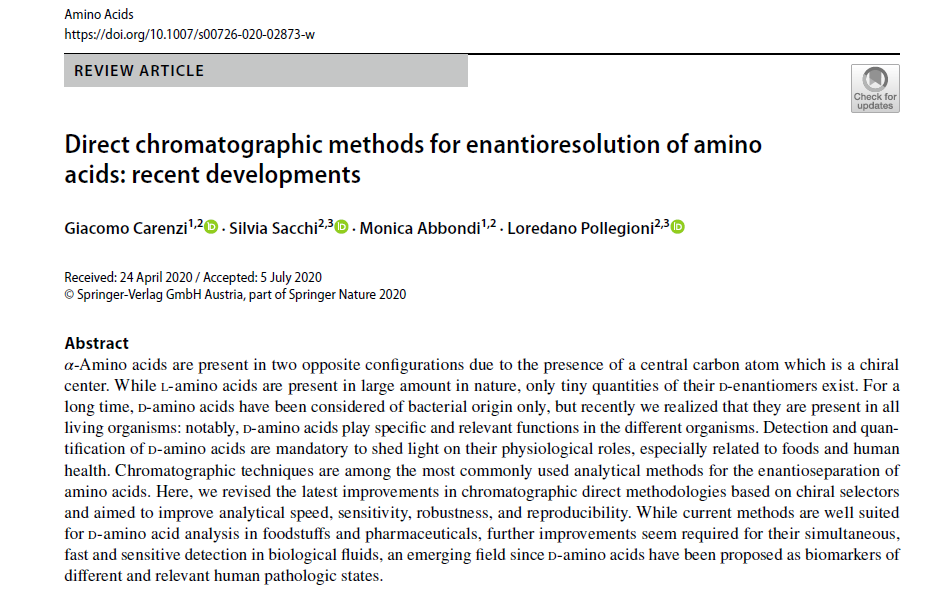
COVID-19 pandemic – We hope you are safe and healthy with your family and loved ones.
Do you have news concerning the D-amino acids field to announce?
Is there a relevant published paper to mention?
Write us and take the advantage of this bimonthly Newsletter.
A NEW PAPER OF DAAIR CENTER
We are thrilled that the third paper of DAAIR center has been published. It is a review paper focusing on analytical methods to detect D-amino acids.

D-AA AND EVOLUTION:
- Microchemical identification of enantiomers in early-branching animals: Lineage-specific diversification in the usage of D-glutamate and D-aspartate
Leonid L. Moroz, Dosung Sohn, Daria Y. Romanova, Andrea B. Kohn
Biochemical and Biophysical Research Communications Volume 527, Issue 4, 5 July 2020, 947-952
D-amino acids are present in all organisms where they can play different roles. In this work the authors performed a comparative survey of L-/D-Asp and L-/D-Glu in four phyla of early-branching Metazoa: cnidarians (Aglantha); placozoans (Trichoplax), sponges (Sycon) and ctenophores (Pleurobrachia, Mnemiopsis, Bolinopsis, and Beroe), which are descendants of ancestral animal lineages distinct from Bilateria. Notably, the placozoans, cnidarians, and sponges had high micromolar concentrations of D-Asp, whereas D-Glu was undetectable, while in ctenophores the latter D-amino acid was the dominant enantiomer. These results allow to shed light on lineage-specific diversifications in the recruitment of D-amino acids and suggest distinct signaling functions of these D-amino acids early in the animal evolution. MORE
- Natural Occurrence, Biological Functions, and Analysis of D-Amino Acids
Shuang-Xi Gu, Hai-Feng Wang, Yuan-Yuan Zhu, Fen-Er Chen
Thieme Open Access DOI https://doi.org/ 10.1055/s-0040-1713820
This review covers the recent developments on the natural occurrence, functional elucidation, and analysis of D-amino acids. The rapid development of chiral analytical techniques for D-amino acids pushed the studies on their existence, formation and biological roles (under physiological and pathological conditions). MORE
ROLE OF D-AAs:
- D-Serine, the Shape-Shifting NMDA Receptor Co-agonist
Coyle, J.T., Balu, D. & Wolosker, H.
Neurochem Res 45, 1344–1353 (2020). https://doi.org/10.1007/s11064-020-03014-1
This review focuses on the evidence in support of the scenarios and the artifacts that misled investigators of the true identity of D-Ser in modulating NMDA receptors. Starting from the concept of “shape-shifting” (a phenomenon referring to the ability to physically change from one identity to another, typically from an innocuous entity to a destructive one) the authors reviewed the “shape-shifted” of D-Ser. A reading absolutely required to understand recent advances in the field. MORE
- D-Alanine: Distribution, origin, physiological relevance, and implications in disease
Lee CJ, Qiu TA, Sweedler JV.
Biochim Biophys Acta Proteins Proteom. 2020;1868(11):140482. doi:10.1016/j.bbapap.2020.140482
Most of the studies concerning D-AAs physiological role and functions in mammals have been focused on D-Ser and D-Asp. Now, thanks to continuous improvements in our analytical methods sensitivity, the functional significance of D-AAs present in trace amount in animal tissues is also coming to light. In particular, D-Ala has been discovered to be physiologically active in the nervous and the endocrine systems, and appears a potential biomarker for pathological conditions, among which neurological, psychiatric and renal disorders. Here the authors provide an interesting overview of the distribution, origin, function, and disease implications of this unusual endogenous D-amino acid. MORE
D-AAs AND PATHOLOGIES:
- D-Serine as the gatekeeper of NMDA receptor activity: implications for the pharmacologic management of anxiety disorders
Wolosker, H., Balu, D.T.
Transl Psychiatry 10, 184 (2020). https://doi.org/10.1038/s41398-020-00870-x
Fear, anxiety, and trauma-related disorders, including post-traumatic stress disorder, are common and debilitating: they are associated with excessive fear reactions. Actually, an wide literature reports on the relevance of NMDA receptor function in regulating these behaviors. This excellent review discusses how the systems that regulate the synaptic availability of D-Ser could be targeted to improve the pharmacologic treatment of anxiety-related disorders where the desired outcomes are the facilitation of fear extinction, as well as mood and cognitive enhancement. MORE
- An Ensemble Approach to Predict Schizophrenia Using Protein Data in the N-methyl-D-Aspartate Receptor (NMDAR) and Tryptophan Catabolic Pathways.
Lin E, Lin CH, Hung CC, Lane HY
Front Bioeng Biotechnol. 2020 Jun 4;8:569. doi: 10.3389/fbioe.2020.00569. PMID: 32582679; PMCID: PMC7287032
The enzyme D-amino acid oxidase (DAAO) and its interaction partner pLG72 have been implicated in NMDA receptor pathway for schizophrenia, as well as melatonin (which is related to the tryptophan catabolic pathway). To develop an ensemble boosting framework with random undersampling for determining disease status of schizophrenia, a prediction approach resulting from the analysis of genomic and demographic variables (levels of DAAO, pLG72 and melatonin, age, and gender of 355 schizophrenia patients and 86 unrelated healthy individuals) has been established. A causal link between DAAO and pLG72 protein levels in influencing schizophrenia disease status was identified. MORE
- Serine Racemase Expression by Striatal Neurons
Takagi, S., Puhl, M.D., Anderson, T. et al.
Neurons. Cell Mol Neurobiol (2020). https://doi.org/10.1007/s10571-020-00880-9
D-Ser is synthesized by serine racemase (SR) which is expressed primarily in neurons, but not in quiescent astrocytes. This study investigated the localization of D-Ser and SR in the mouse striatum and the effects of genetically silencing SR expression in GABAergic interneurons (iSR−/−). The authors reported that GABAergic medium spiny neurons receiving dopaminergic inputs in striatum robustly and uniformly express SR. The iSR−/− mice showed a blunted response to the hedonic and stimulant effects of cocaine, without affecting anxiety-related behaviors, this reinforcing the conclusion that D-Ser in striatal GABAergic neurons plays an important role in mediating dopaminergic stimulant effects. This study suggests that SR in striatal GABAergic neurons produced D-Ser which acts as an autocrine transmitter whereby the GABAergic neurons control the excitability of their NMDARs by determining the availability of the co-agonist D-Ser. MORE
- New insights on the influence of free D-aspartate metabolism in the mammalian brain during prenatal and postnatal life
Francesco Errico, Mariella Cuomo, Nadia Canu, Viviana Caputo, Alessandro Usiello
Biochimica et Biophysica Acta (BBA) – Proteins and Proteomics, Volume 1868, Issue 10, October 2020, 140471 https://doi.org/10.1016/j.bbapap.2020.140471
D-Asp is abundant in the mammalian embryonic brain and decreases in the postnatal period because of the onset of the catabolic enzyme D-aspartate oxidase (DDO or DASPO). D-Asp stimulates both glutamatergic NMDA receptors and metabotropic Glu5 receptors. A dichotomous impact of D-Asp signaling on NMDA receptor-dependent processes is known and this unveils a neuroprotective role for DASPO during aging. Here, the authors reviewed the in vivo influence of altered D-Asp metabolism on the modulation of glutamatergic functions and its involvement in translational studies. MORE
ANALYTICAL METHODS:
- Biosensors for D-Amino Acids: Detection Methods and Applications
Rosini, E., D’Antona, P., Pollegioni, L.
International journal of molecular sciences Volume 21, Issue 13, 27 June 2020
D-enantiomers of amino acids (D-AAs) are only present in low amounts in nature, frequently at trace levels, and for this reason, their biological function was undervalued for a long time. Classical analytical methods (i.e. gas chromatography, HPLC, and capillary electrophoresis) are time-consuming, expensive, and not suitable for online application. This review provides an update concerning biosensors for detecting and quantifying D-AAs and their applications for safety and quality of foods, human health, and neurological research, and reports the main challenges in the field. MORE
ENZYMES ACTIVE ON D-AA & BIOTECHNOLOGICAL APPLICATIONS:
- Biochemical characterization of mouse D-aspartate oxidase
Puggioni V., Savinelli A., Miceli M., Molla G., Pollegioni L., Sacchi, S.
Biochimica et Biophysica Acta – Proteins and Proteomics Volume 1868, Issue 10, October 2020, Article number 140472
Rodents have been widely used as models for deciphering molecular mechanisms and for testing novel therapeutic targets and drugs, but human targets can significantly differ. Based on these considerations, here the structural and functional properties of the mouse D-aspartate oxidase (DASPO) were investigated, in particular kinetic properties, ligand and flavin binding, oligomerization state and protein stability. These properties were compared with those of the human enzyme (80% sequence identity) highlighting a different oligomeric state and a lower activity for the mouse DASPO, which apoprotein species exists in solution in two forms differing in FAD affinity. MORE
- Biochemical characterization of D-aspartate oxidase from Caenorhabditis elegans: its potential use in the determination of free D-glutamate in biological samples
Masumi Katane, Hisashi Kuwabara, Kazuki Nakayama, Yasuaki Saitoh, Tetsuya Miyamoto, Masae Sekine, Hiroshi Homma
Biochimica et Biophysica Acta (BBA) – Proteins and Proteomics, Volume 1868, Issue 8, August 2020, 140442 https://doi.org/10.1016/j.bbapap.2020.140442
Mammalian D-aspartate oxidase (DDO or DASPO), which exhibits higher activity toward D-Asp than D-Glu, is presumed to regulate levels of D-Asp in the body and is not thought to degrade D-Glu in vivo. Three DDO isoforms are present in the nematode Caenorhabditis elegans, DDO-1, DDO-2, and DDO-3, all of which are catalytically active. The recombinant C. elegans DDO-1 produced in E. coli was purified and showed a noncovalently but tightly attached FAD cofactor. Differently from mammalian (rat) DDO, C. elegans DDO-1 efficiently and selectively degraded D-Glu (in addition to D-Asp). MORE
- Synthesis and preliminary evaluation of 4-hydroxy-6-(3-[11C] methoxyphenethyl)pyridazin-3(2H)-one, a 11C-labeled D-amino acid oxidase (DAAO) inhibitor for PET imaging
Xiaoyun Deng, Yiding Zhang, Zhen Chen, Katsushi Kumata, Richard Van, Jian Rong, Tuo Shao, Akiko Hatori, Wakana Mori, Qingzhen Yu, Kuan Hu, Masayuki Fujinaga, Hsiao-Ying Wey, Yihan Shao, Lee Josephson, Giulia Murtas, Loredano Pollegioni, Ming-Rong Zhang, Steven Liang
Bioorganic & Medicinal Chemistry Letters https://doi.org/10.1016/j.bmcl.2020.127326
Selective DAAO inhibitors have demonstrated promising therapeutic effects in clinical studies, including clinically alleviating symptoms of schizophrenic patients and ameliorating cognitive function in Alzheimer’s patients with early phase. Here, the synthesis and preliminary evaluation of a 11C-labeled positron emission tomography ligand based on a DAAO inhibitor, DAO-1903 (8) was reported. In vitro autoradiography studies indicated that the ligand possessed high in vitro specific binding to DAAO, while in vivo dynamic PET studies demonstrated that [11C]8 failed to cross the blood–brain barrier. MORE
The D-amino acids International Research Center “DAAIR“ has been established in Gerenzano (Varese, Italy) in 2019 with the aim to support and perform scientific research projects and activities on the field of D-amino acids (Director Loredano Pollegioni). The Center, located inside the Fondazione Istituto Insubrico Ricerca per la Vita, is aimed to represent a pole of excellence at international level for dissemination and research involving the D-amino acids.
The guiding principle is support the research projects aimed to investigate the involvement of D-amino acids in main physiological processes, from bacteria to humans. The ultimate goal is to actively participate to the elucidation of the mechanisms by which the D-amino acids perform specific functions, and to identify their presence and concentration in different organisms and compartments, also with regards to well-established functional states, with particular emphasis to pathological states. Understand the involvement of D-amino acids in important diseases as a way to set up novel therapeutic strategies.
Contacts: info@d-aminoacids.com;
director@d-aminoacids.com;
www.d-aminoacids.com
https://www.d-aminoacids.com/
mailing address: info@d-aminoacids.com
Commenti recenti